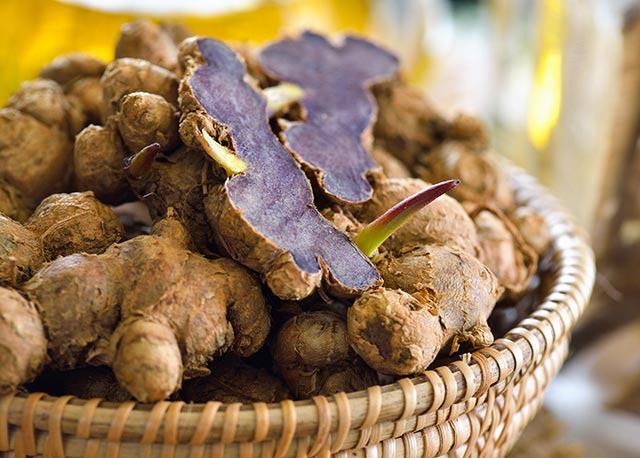Certain symptoms of knee osteoarthritis can be reduced with Thai black ginger
11/29/2018 / By Michelle Simmons

People who regularly suffer from the effects of knee osteoporosis might want to give Thai black ginger (Kaempferia parviflora) a shot for relief. In a study published in the Journal of Natural Medicines, scientists found that this type of ginger has been found to reduce the symptoms of knee osteoarthritis.
Thai black ginger is a plant native to Southeast Asia that looks similar to the ordinary ginger, except that the inner portions of black ginger are purple-black in color. This herb has been used in both food and medicine, thanks to its anti-inflammatory properties. In Thailand, it’s used to boost testosterone production, improve vitality, and treat metabolic problems. However, no study has been made on its effect on osteoarthritis. A team of researchers from Japan took on the task, investigating the effects of Thai black ginger extract against osteoarthritis.
For the study, the team looked at the effect and mechanism of Thai black ginger extract on mice with knee osteoarthritis. The results revealed that the Thai black ginger extract reduced pain and decreased the severity of osteoarthritic cartilage lesions. In addition, the Thai black ginger extract and its active components, particularly 5,7-dimethoxyflavone and 5,7,4?-trimethoxyflavone, reduced the expression matrix metalloproteinases (MMPs). MMPs are the main extracellular matrix enzymes responsible for the degradation of collagen within cartilage. Overall, the Thai black ginger extract suppressed knee osteoarthritis and inhibited MMPs.
Based on the findings of the study, the researchers concluded that Thai black ginger can alleviate the effects of knee osteoarthritis. (Related: Purify your body: Yoga basti found to remedy osteoarthritis symptoms.)

Managing osteoarthritis naturally
Knee osteoarthritis, no matter what the cause is, will always result in pain and a decreased ability to live an active life. Fortunately, there are ways to relieve pain and even delay — or prevent — knee replacement surgery without the use of pharmaceutical drugs. These include the following:
- Exercise regularly and lose extra weight: The Osteoarthritis Research Society International (OARSI), the American Academy of Orthopaedic Surgeons (AAOS), and the American College of Rheumatology (ACR) heavily emphasize the importance of exercising regularly and losing extra weight on reducing pain due to knee osteoarthritis. Even just losing a little weight can have a great impact. Every pound lost reduces the weight on the knees by around 4 pounds, according to research. Moreover, losing around five percent of body weight eases pain and improves one’s ability to move. Furthermore, losing more weight delays the progression of the disease. A study published in the Journal of the American Medical Association also revealed that losing weight decreases levels of body-wide inflammation that adds to joint damage in osteoarthritis and associated conditions. Exercise can also reduce the pain and disability of knee osteoarthritis by preventing the domino effect of inactivity, which results in weakened muscles, worsening osteoarthritis, increased pain, and less mobility. The OARSI and ACR particularly recommend tai chi, which is a low-impact exercise based on slow, flowing movements. Research shows that this particular exercise relieves pain and stiffness, and improved physical function by up to 36 percent in osteoarthritis patients.
- Get help from a physical therapist: Exercises prescribed and supervised by a physical therapist are safer and more effective because they know your weak spots. A physical therapist can also help you improve your balance, strength, and joint alignment. A physical therapist typically prescribes exercises that improve strength and flexibility in the hips, hamstrings, and quadriceps.
- Try spa therapy: The OARSI recommends balneotherapy, a spa therapy that can include soaking in heated mineral water, visiting mud baths, or getting a water massage. This is especially helpful for people with osteoarthritis in multiple joints and complicating conditions. Several studies have also shown that doing water therapy for more than an hour almost every day for three weeks can improve pain and stiffness.
The ideal way to apply these tips is being knowledgeable about your disease, such as knowing what is beneficial and what is not. For example, in exercise, one should recognize the difference between beneficial exercise between activities that stress joints. Bending, stooping, kneeling, soccer, and downhill skiing are some examples of activities that may do more harm than good in people with knee osteoarthritis. Understanding one’s physical limitations is important in preventing the condition from worsening.
Read more news stories and studies on natural treatments for osteoarthritis by going to AlternativeMedicine.news.
Sources include:
Submit a correction >>
Tagged Under:
alternative medicine, bone health, Bones, herbal medicine, Herbs, joint disease, joints, Kaempferia parviflora, knee osteoarthritis, natural cures, natural medicine, Osteoarthritis, Thai black ginger
This article may contain statements that reflect the opinion of the author





















